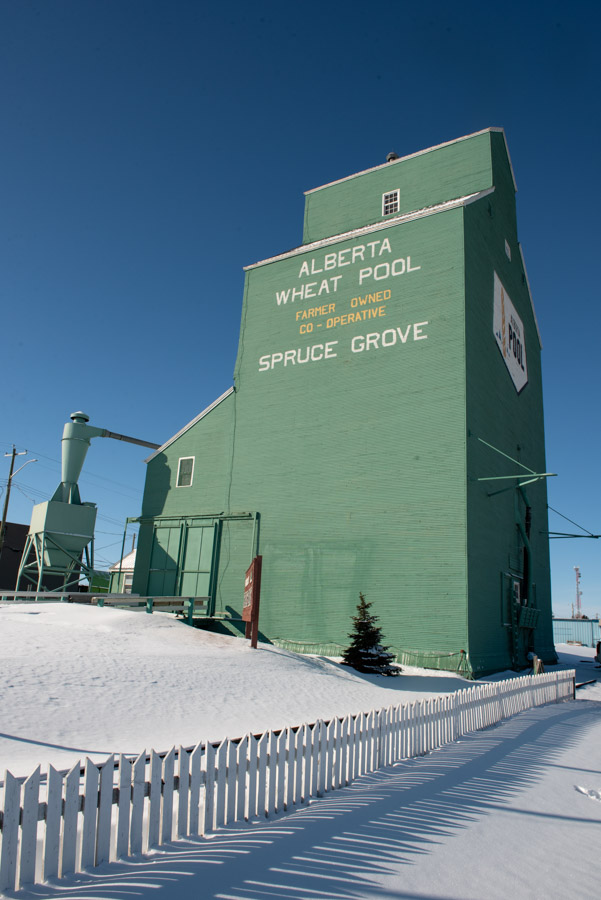Then & Now
The Spruce Grove Grain Elevator Museum: a symbol of the city’s agrarian pas
July, 2020
The story of Spruce Grove’s Grain Elevator Museum is not just a story of an old building, but rather, a city itself. Like many communities across the prairies, Spruce Grove grew around its first elevator. Before it existed, farmers in the area would have to make the day-long journey to Edmonton and back for supplies. But, when the first grain elevator rose high into the sky above Spruce Grove, businesses started popping up one by one around it in order to supply the farmers with their every need.

1900s and 1910s
When Daniel Brox and his wife Marion Stedelbauer found out they could not afford to buy land in their hometown of Elmira, Ontario, they decided to move to Alberta, following others from their home who had settled in an area west of Edmonton called Spruce Grove. In 1896, they bought a piece of land–today known as Broxton Park–because of its close proximity to the original settlement of Spruce Grove. However, in 1908, the Grand Trunk Pacific Railway came through town, establishing a train station directly in line with what is now Main Street. This resulted in the relocation of the settlement three quarters of a mile west to the present location of the City of Spruce Grove.
Being the entrepreneur that he was, Brox wasted no time taking advantage of the new railway line. In 1908, he built Spruce Grove’s first grain elevator directly to the east of the one standing today using lumber from his own land, helping to transform Spruce Grove into the bustling grain-trading centre that it would become. By 1917, Spruce Grove had caught the attention of the United Grain Growers, who in turn erected the community’s second grain elevator on the site of the one standing today. In 1919, this elevator would burn down, but was quickly replaced by another, becoming Spruce Grove’s first to grace the name of the Alberta Wheat Pool.
1950s and 1960s
By the 1950s, the grain business was really booming, and Spruce Grove’s elevator count now stood tall at three. But disaster struck on the morning of June 17, 1958 as the entire community watched the 39-year-old Alberta Wheat Pool elevator–full of wheat, oats, and barley–burn to the ground. Residents feared that the fire might spread throughout the village, and for a week after the blaze, an around-the-clock standby fire crew was needed in case the wind caused any of the embers to flare up.
Even though two of the village’s elevators were still functioning in the days and weeks immediately following the fire, they were simply not enough to meet the usual market demands. Therefore, construction was started on a new, state-of-the-art elevator designed with a 76,000-bushel capacity. In just four months, the now famous “big green giant” was completed, and by 1961, it stood tall and proud as one of 2,173 prairie skyscrapers.
1980s and 1990s
As the 1980s progressed, grain elevators were advancing with more and more being constructed out of concrete or steel instead of wood. In May 1987, Spruce Grove’s 1929-built Searle Grain Elevator was torn down due to its declining state, becoming the first of the city’s three elevators to permanently disappear from the skyline. Four years later in June 1991, Spruce Grove’s second last remaining elevator, the Fuhr Farms Elevator, which had replaced Brox’s elevator in 1927, came tumbling down in another fire that nearly spread to the nearby big green giant. By 1995, due to a combination of more durable elevators and declining Canadian grain exports, two of the city’s three elevators had either been torn down or destroyed by fire, and it seemed as though the big green giant’s days were also numbered.
On April 1, 1995, speculation became reality when the Alberta Wheat Pool officially ended all operations at Spruce Grove’s last standing elevator, slating it for demolition within a year. Luckily, for fear of losing the city’s last elevator, and a big portion of history along with it, the Spruce Grove and District Agricultural Heritage Society (AG), formed in 1972, and run by a group of local volunteers, immediately intervened in hopes of finding a way to preserve the local landmark. After two long years of tense negotiations with the City of Spruce Grove, the Alberta Wheat Pool, and Canadian National Railway (CN), it was finally decided that the AG would purchase the elevator from the Alberta Wheat Pool for $1, and the land from CN for $35,000, with plans to convert the site into a museum, tourist attraction, and community storehouse for artifacts.
2000s
In 2001, the AG society, led by its president, George Sewell, started lobbying for what it called an “Elevator Emporium.” The emporium would be constructed on the elevator museum site to resemble a period train station. It would house the Spruce Grove archives, the museum collection, a tea house, gift shop, conference room, as well as a business incubator for small-scale producers, such as a farmer looking for a place to store, process, or market products from a specific crop. While this project has yet to see the light of day, other things like a $63,000 parking lot and $18,000 paint and repair job were completed in 2002.
2010-Today
The AG society continues to fund the usual upkeep necessary for maintaining a 60-year-old building, with significant projects over the last 10 years being the restoration of the old Spruce Grove water tower in 2011, the repainting and restoration of the elevator in 2012, foundation wall repair and front and back door replacements in 2016.
Today, the elevator remains operational and the site has become a very busy attraction welcoming thousands of visitors each summer from across Canada and around the world. The site hosts old fashioned carnivals and fairs specifically tailored towards children and families, as well as several annual summer fundraising events such as Flapjacks at the Tracks Community Pancake Breakfast, the Farm and Heritage Carnival, and the Harvest Fair. These events are for the purpose of raising funds to support the ongoing maintenance and preservation of the grain elevator and water tower, educational programs, and the long-term goal of an elevator emporium.









